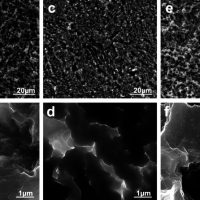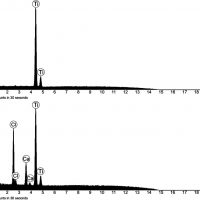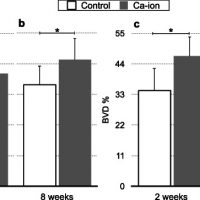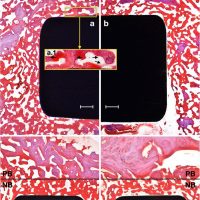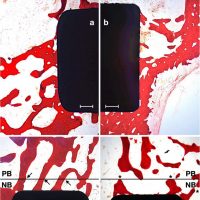- Autor:
- Eduardo Anitua
- Ricardo Tejero
- Andreia Cerqueira
- Francisco Romero Gavilán
- Iñaki García Arnáez
- Cristina Martinez Ramos
- Seda Ozturan
- Mikel Azkargorta
- Félix Elortza
- Mariló Gurruchaga
- Isabel Goñi
- Julio Suay
Influence of calcium ion-modified implant surfaces in protein adsorption and implant integration
Abstract
Background: Calcium (Ca) is a well-known element in bone metabolism and blood coagulation. Here, we investigate the link between the protein adsorption pattern and the in vivo responses of surfaces modified with calcium ions (Ca-ion) as compared to standard titanium implant surfaces (control). We used LC-MS/MS to identify the proteins adhered to the surfaces after incubation with human serum and performed bilateral surgeries in the medial section of the femoral condyles of 18 New Zealand white rabbits to test osseointegration at 2 and 8 weeks post-implantation (n=9).
Results: Ca-ion surfaces adsorbed 181.42 times more FA10 and 3.85 times less FA12 (p<0.001), which are factors of the common and the intrinsic coagulation pathways respectively. We also detected differences in A1AT, PLMN, FA12, KNG1, HEP2, LYSC, PIP, SAMP, VTNC, SAA4, and CFAH (p<0.01). At 2 and 8 weeks post-implantation, the mean bone implant contact (BIC) with Ca-ion surfaces was respectively 1.52 and 1.25 times higher, and the mean bone volume density (BVD) was respectively 1.35 and 1.13 times higher. Differences were statistically significant for BIC at 2 and 8 weeks and for BVD at 2 weeks (p<0.05).
Conclusions: The strong thrombogenic protein adsorption pattern at Ca-ion surfaces correlated with significantly higher levels of implant osseointegration. More effective implant surfaces combined with smaller implants enable less invasive surgeries, shorter healing times, and overall lower intervention costs, especially in cases of low quantity or quality of bone.
Keywords: Blood coagulation; Implant surface design; Osseointegration; Protein adsorption; Titanium implants.

 Español
Español
 English
English
 Français
Français
 Italiano
Italiano

